Detailed Itinerary
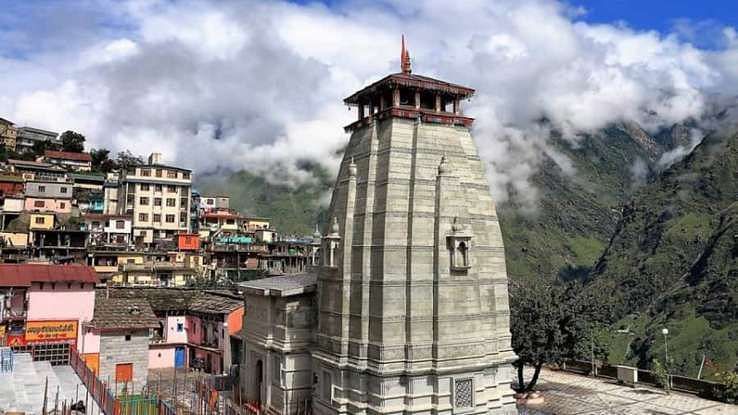
Day 1
Haridwar to Joshimath
• Altitude: 6,696 ft
• Time taken: 9 hours drive from Haridwar
If you are travelling by train, reach Haridwar or Dehradun early in the morning or the previous night. Shared taxis are available from outside either of the railway stations early in the morning.
Another option is to take an overnight bus from Dehradun to Joshimath.
Day 2
Joshimath to Kalpeshwar via Lyari. Return to Helang and drive to Saggar
• Altitude: 7,217 ft
• Time taken: 5-6 hours trek including the walk to Lyari if the road is broken.
• Trek gradient: Easy - moderate. Mostly flat trails to villages and fields
• Water sources: You will get one water source on the trail to refill your water bottles.
The total trek distance from Lyari to Kalpeshwar is 4.5 km. Most of the trek consists of a flat walk and is not very difficult.
Set out early from Joshimath. This way, you can return and proceed to Saggar, which is a 2 hours drive from Helang.
The idyllic trek is through quaint villages of the Urgam valley. You walk past fields initially and then through lush meadows. You can see the Kalpganga River to your right.
The next stop on this trek is Rudranath. The other option is to drive from Helang to Sagar Village and begin the trek from there. The details mentioned here are for going to Rudranath from Sagar via Panar and descending via Nala Pass and Anusuya Devi temple. You can also reverse this route. However, keep in mind that the Panar route has a lot of steps on a steep trail, which can make descending this route tough on your knees.
Day 3
Sagar to Panar
• Altitude: 11,155 ft
• Time taken: 6-8 hours; 12 km
• Trek gradient: Difficult. Steep climb all the way to Panar
• Water sources: You can refill your water bottles from streams or at dhabas on the trail.
Take the route through Sagar. This is where Suryavanshi King Sagar, a descendant of King Harishchandra, had spent his childhood.
The route is a very steep climb through a dense forest. The trail is well laid, with steps cut out all the way to Panar.
On the way you hear the chirping of birds, the noise of the crickets and cicadas, rustling of leaves by the langurs. The gurgling waterfalls add to the surreal experience. Drinking water directly from the freshwater streams is rejuvenating. There are hardly any trekkers to be seen.
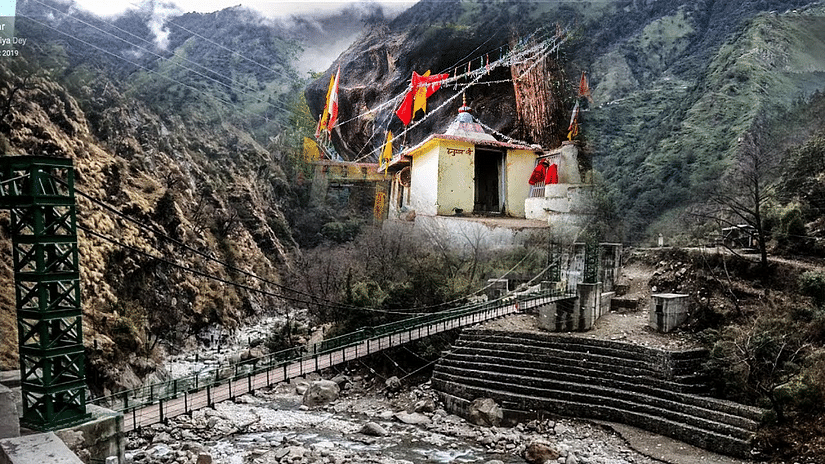
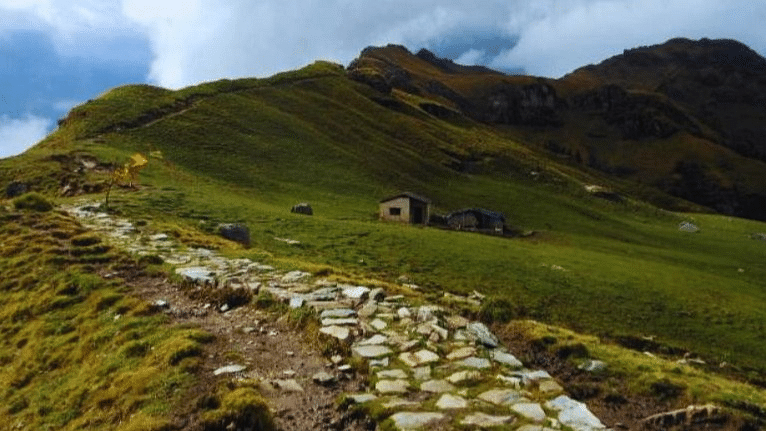
There are less than half a dozen dhabas on the entire route to Rudranath. These dhabas provide good food and basic overnight stay facilities. One positive aspect of these dhabas was the availability of enclosed toilets.
From Panar you can see the beautiful snow-capped mountains of Nanda Devi, Trishul and Nanda Ghunti and the Bandarpoonch massif. In the month of August and September Panar turns into a carpet of pinkish red flowers. There is a dhaba in a smaller meadow just before Panar (Lungti Bugyal), where you can stay overnight.
Day 4
Panar to Rudranath. Return to Panch Ganga
Rudranath Temple jpg
• Altitude: 11,811 ft
• Time taken: 6-7 hours; 11 km
• Trek gradient: Moderate-Difficult. Steep climb all the way to Panar
• Water sources: None till you reach Panch Ganga. Carry at least 2 litres of water.
Start early in the morning for Rudranath. Take the trail that moves towards the ridge to the left. You will see some huge boulders and snow-capped peaks to your left.
The trail gradually climbs up the ridge. You will notice some undergrowth on the way. After 25-30 minutes of ascent, you can see the Panar meadows below. In another 30-40 minutes, you reach a huge overhanging boulder on the left. From here, the scene is magnificent – the vast green meadows of Panar below and snow-capped peaks in front engulfed in clouds.
Continue on the trail that climbs up the ridge. As you climb up you see huge boulders on the right and in the front. You will pass several boulders and eventually reach the ridge between Panar and Rudranath. The views of the Himalayas from this ridge are unmatched. You are surrounded on all sides by snow-capped peaks and lush green valleys.
This is also the place where you see another trail going down to the left. This is the one to Anusuya Devi, which you will take on the return.
Proceed ahead on the trail. You are now surrounded by colourful flowers and shrubs. Notice the temporary shepherd settlement made of stone to your left. Continue on the mud trail that gradually ascends, keeping the valley to your left. You will soon see prayer bells and flags in the distance. It takes 15-20 minutes to reach them.
This is Panch Ganga, the highest point on this trail. It takes 3-3.5 hours to reach here from Panar. En route, you also pass Pitradhar, where our forefathers are said to have departed for the other realms. There is a small unattended shrine here. The view from Rudranath temple is stupendous. We see a wide range of icy Himalayan mountain peaks. Nanda Devi and Kamet peaks look very enticing, especially at sunrise.
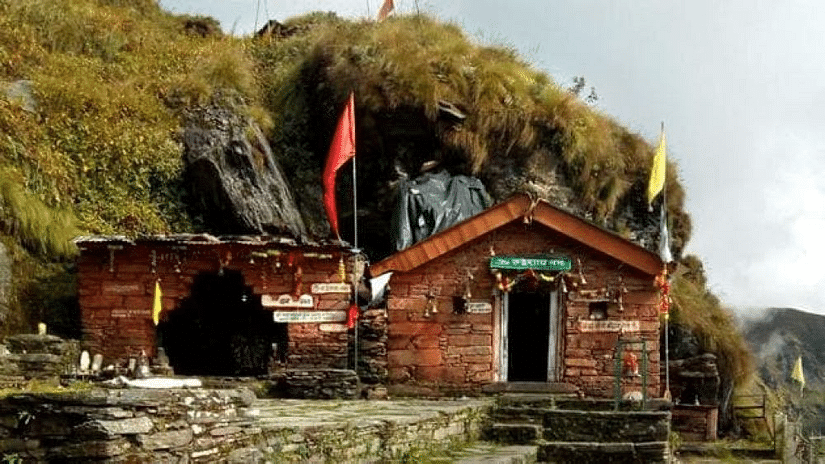
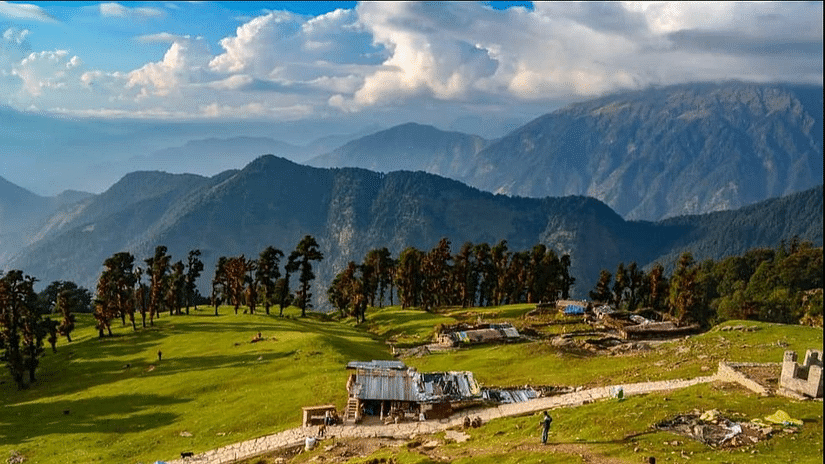
From Panch Ganga, the trail now descends into the valley. You see bright flowers and shrubs around. This valley is known for its medicinal herbs. Continue on the trail as it climbs up a ridge. Spread over a couple of hundred metres on either side of the ridge are colourful wildflowers and a lush green meadow.
Rudranath shrine becomes visible at a distance after an hour of hike. The trail descends first and then ascends. In 25-30 minutes you will reach a brightly painted tourist hut. It has 2 rooms that are used by pilgrims and tourists who wish to stay overnight at Rudranath. You can also make your way back to Panch Ganga and stay at a dhaba there.
Day 5
Panch Ganga to Mandal/ Chopta Time taken 3 hours; 5km
Chopta is about an hour's drive from Mandal. This is a very beautiful drive.
Chopta is the base for a small but uphill trek to Tungnath temple. Tungnath is the highest-located Shiva temple in the world.
Day 6
See Tungnath. Reach Ransi
• Altitude: 12,083 ft
• Time taken: 2-3 hours; 6 km one side
• Trek gradient: Moderate. Steep ascent to Tungnath
• Water sources: None. Carry at least 2 litres of water.
The trek from Chopta to Tungnath is accessible via a cemented pilgrim trail. The trail ascends sharply via a series of 11 scissor bends. The walk is pleasant but is a very steep climb. The trek up to Tungnath temple is approximately 3 km. After you reach the 10th scissor bend, look for a flag and a small open temple towards your right side.
You can now see Chandrashila Peak and the Tungnath temple complex at the base of the peak. The views from here onwards are incredible. A connecting peak leading to Chandrashila, known as Ravanshila, is visible to your right.
Tungnath temple is only half a kilometre away from here. Towards your left, overlooking the valley is a section of Birch trees (Bhojpatra). This is a haven for birds like Monal and Griffin vultures. Take the 11th and last bend to reach the famous and holy Tungnath temple.
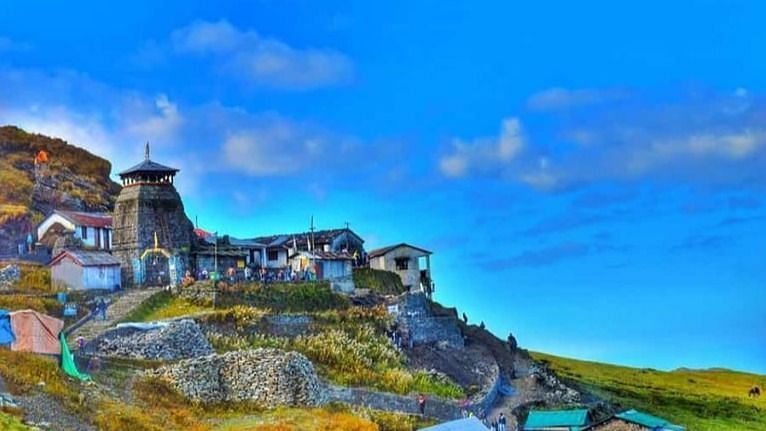
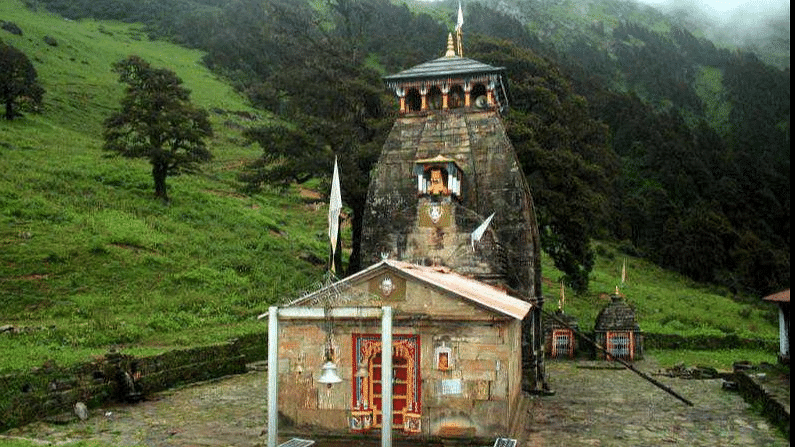
The temple is closed in winter and you will find snow here from late December until around April.
Return to Chopta on the same trail. Board the afternoon bus to Ukhimath. Take the connecting bus from Ukhimath and reach Ransi by evening. The connecting bus waits for the bus from Chopta before starting from Ukhimath.
Ukhikmath is well known for the famous Omkareshwar temple, home to the idols from Kedarnath and Madhyamaheshwar in winter.
Day 7
Trek to Nanu, en route Madhyamaheswar
• Altitude: 7,743 ft
• Time taken: 6 hours; 10 km
• Trek gradient: Moderate.
• Water sources: Carry two litres of water and keep hydrating yourself. You can refill your water bottles from dhabas along the trail.
Ransi is the starting point for another arduous trek to Madhyamaheshwar. The trail is well-marked and easy to follow. The flora on the route is amazing and so is the fauna. You will see butterflies, mountain goats, lizards, sheep, guard dogs, monkeys, several birds etc. The village kids seem to be living their lives to the fullest.
The temple itself is set against a very beautiful backdrop of sloping hills and meadows. Another small trek to Budha Maheshwar is recommended for those who want to see a nice sunrise.
The trail from Ransi begins with a gentle ascent for about 25 minutes and tapers off into a level walk. Another 10 minutes into it, you will see the trail passing through a small stream near a stone-made hut which is a part of the “Gharat” system used to grind wheat using the ancient water wheel technology. Continue on the mud path for 10-15 minutes and you will see that the trail now enters a green forest with huge trees on both sides. The trail now moves downwards on a stone-paved path.
Continue descending on the stone-paved trail for 45 minutes to an hour till you reach the bridge over a river, with a grand view and the deafening roar of a waterfall cascading down. Cross the river coming from your left on a steel bridge and you are on the trail, which now starts to climb up gently. Continue on the trail for 20 minutes until you see a huge boulder on your left. The overhanging boulder with walls built on 2 sides serves as a temporary rest area. Continue the upward climb for 1 km and you will reach Gaundhar, a scenic place. On the way you cross 2 more bridges at an interval of 5-10 minutes each. Also, you come across a small temple on the right-hand side of the trail. It takes around 2 hours to reach Gaundhar from Ransi. You can break here for lunch.
The trail now ascends in the north-west direction from Bantoli towards Nanu. Continue ascending on the trail for 15- 20 minutes and you will see the top view of thick forested growth, with two rivers Madhymaheshwar Ganga and Martyenda Ganga and a bridge on one of the rivers. The trail which we traversed an hour ago is also in focus. Another 45 minutes into the trail you will come across a huge boulder on the left side of the trail.
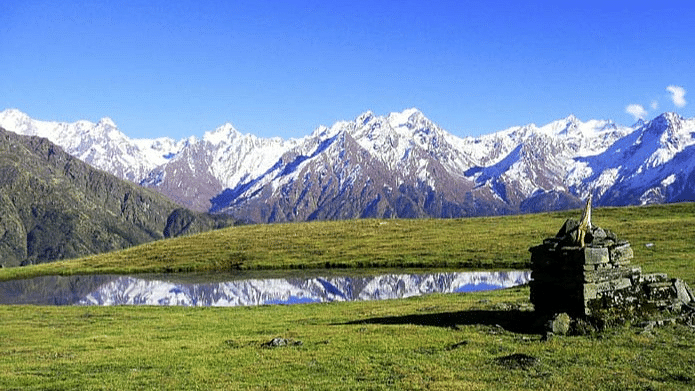
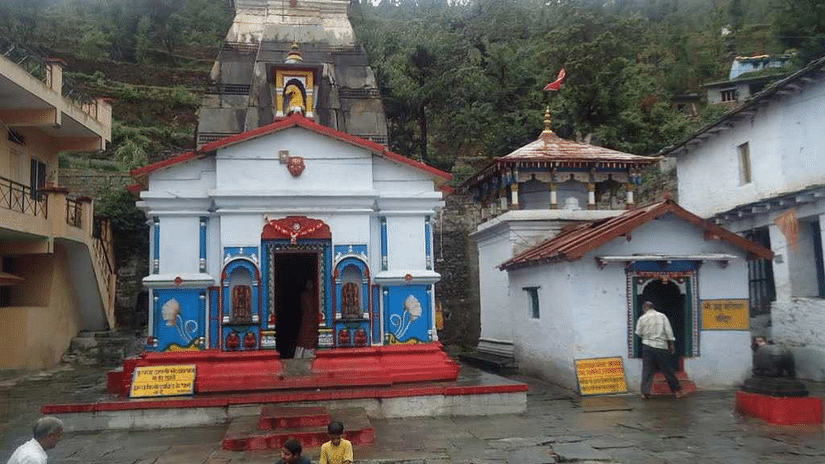
Day 8
Trek to Madhyamaheswar. Visit Budha Madhmaheshwar
• Altitude: 11,483 ft
• Time taken: 6 hours; 6 km
• Trek gradient: Moderate.
• Water sources: Carry two litres of water and keep hydrating yourself. You can refill your water bottles from dhabas along the trail.
This is a relatively easy day for trekking. Proceed ahead on the trail that goes uphill on the stone-paved path. You can see the trail going zig-zag upwards. After 35 – 40 minutes of the hike, you will come across a mushroom-shaped rest area. There are several rest areas on the trail as this is used by the pilgrims going to Madhymaheshwar. After 50 minutes of the hike, you will see a signboard indicating the name of the place and also the elevation.
You will see a blue water tank and a couple of huts in Moukhom Chatti which is located at 8,596 ft and around 1.5 km from Nanu. Proceed ahead on the trail uphill. The trail takes you through magnificent landscapes and enthralling natural surroundings. Continue on the trail for 5 – 10 minutes and you will see that it now passes through forest cover with trees on either side. The oak forest grows darker after Moukhom Chatti. Another 30- 45 minutes into the hike after Moukhom Chatti you will come across Kun Chatti which is around 1.5 km. You will see a signboard indicating the elevation of 9,121 ft. At Kun Chatti, you will come across a shack named Prince Hotel which serves as a dhaba and resting place. You can get tea/lemon water here.
The last few kilometres are an arduous and continuous climb. Proceed ahead as you now enter the zone of rhododendron forests on both sides of the trail. The fresh little pinkish buds of the flowers or tender leaves, all around, give a dash of warm colour to the landscape. All along the trail, you will see several markings (e.g. K.M. 32) on the way on stones written in black on a white background that indicate the distance. As you venture deep into the forest you come across several Himalayan birds.
After 2 – 2.5 hours into the trek, you will come across some meadows on the right and you will see cattle grazing on green pastures. This indicates that you are near the top. Continue on the trail for another 45 minutes and you will see the trail emerge from the forest as it moves around the mountain to appear at the Madhyamaheshwar meadow. The trail climbs up all the way and becomes flat just before Madhyamaheshwar. At 11,483 ft. Madhyamaheshwar is a unique Himalayan destination with green carpet-like bugyals with plenty of small bushes all around. The calm and serene environment is spellbinding. You will see that the Madhymaheshwar valley shows forest cover in the background, signifying that this place must be getting an abundant amount of rainfall around the year. You can also see corrugated and thatched roof structures along the route to the temple which are guest houses or dhabas.
You can pitch a tent or stay in the temple guest house /local huts.
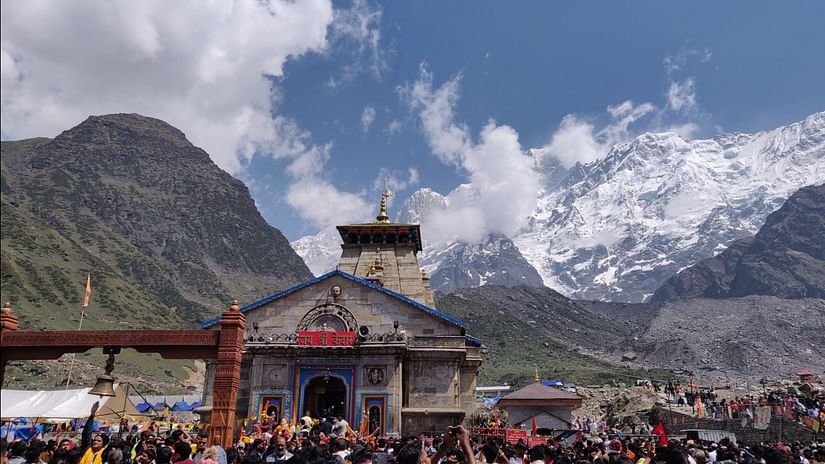
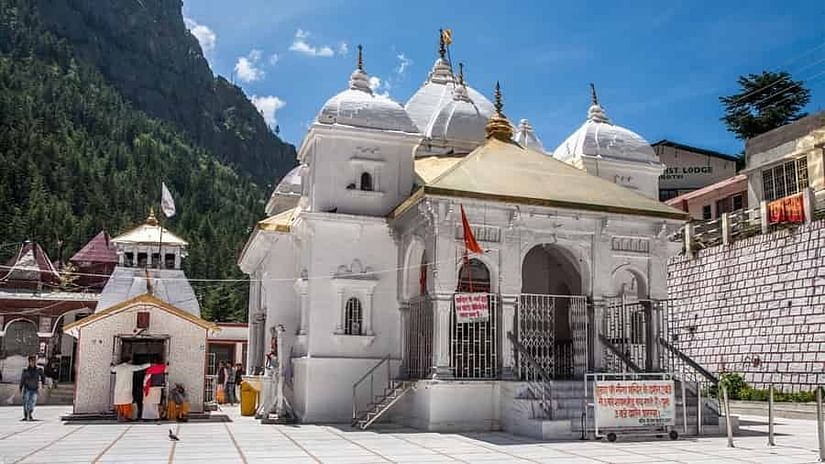
Day 9
Return to Ransi
• Altitude: 6,440 ft
• Time taken: 6-7 hours; 16 km
• Trek gradient: Moderate.
• Water sources: Carry two litres of water and keep hydrating yourself. You can refill your water bottles from dhabas along the trail.
Wake up early in the morning to visit Buda Madhymaheshwar. The sunrise here is spectacular.
Budha Madhymaheshwar is around 1,000 ft higher than Madhymaheshwar. Buda Madhymaheshwar is at the top of the ridge lying to the northwest of the temple. Facing the temple start moving on the trail that connects the ridge on your left keeping the temple to your right. Proceed on the trail for 30 – 45 minutes till you reach the top. You see mesmerizing views of the Chaukhamba group of peaks and Mandani Parbat from here.
After breakfast, descend to Ransi.
Day 10
Reach Guptkashi
The 73 km journey from Ransi to Guptakashi
can be broken down into multiple bus rides. First to Ukhimath, next to Kund, further on to Sonprayag and finally a shared taxi to Gaurikund. You can also hire a private taxi. This costs around Rs.700 from Ransi to Kund.
Gaurikund is where the 18km trek to Kedarnath begins.
Day 11
Guptakashi to Kedarnath
Wake up Early and get ready for the Dham of the Lord Shiva i.e. Kedarnath also known as the home of The Lord Shiva.
Take the Shuttle Service from Sonprayag to Gaurikund and Start your trek thereafter
18 km trek to Kedarnath temple. ( You Can also opt for Dolli, Pony, Pitthu and Helicopter on your own )
Reach Kedarnath and one can go to Evening Darshan after taking some rest.
Dinner and Overnight stay at GMVN Cottages.
Night Stay Kedarnath

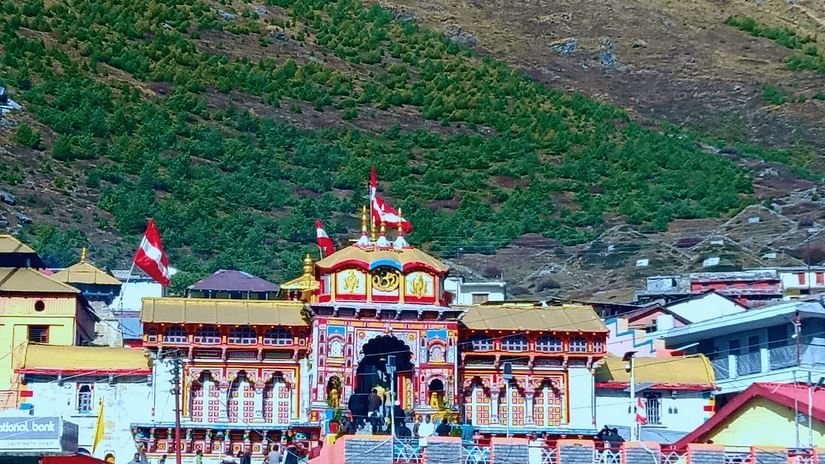
Day 12
Kedarnath to Guptkashi
• Wake up Early around 4 a.m. and witness the Morning Darshan, at Morning you can go inside the GarbhaGraha and see the hump of the Bull.
• After Breakfast trek down from Kedarnath to Sitapur/ Guptkashi
• Reach in the Evening followed by Dinner and rest
Day 13
Guptakashi to Haridwar (180km 6-7 hrs)
• Check out from the hotel.
• Leave for Haridwar after Breakfast.
Yatra Complete with Blessings & Unforgettable memories!!!